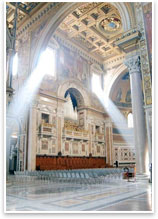 School Addition to Benefit Deaf-Blind and Autistic Students School Addition to Benefit Deaf-Blind and Autistic Students
Collaborative project with university students promotes creative approach
Gilfillan Callahan Nelson Architects uses sensory-centric designs to create an interactive school for differently abled students. Keneyville Elementary School District 20, in the northern suburbs of Chicago, worked with its architect of record to create an interactive school to draw in its special-needs students, who are deaf-blind and autistic, while also serving its traditional school population. The single-story school addition offers a curvilinear spine as the design’s centerpiece. 
 AIA Center for Communities by Design Names 10 SDAT Communities for 2009 AIA Center for Communities by Design Names 10 SDAT Communities for 2009
The AIA Center for Communities by Design has selected 10 communities for participation in the 2009 Sustainable Design Assessment Team (SDAT) program. This community assistance program focuses on the principles of sustainability and brings teams of volunteer professionals (such as architects, urban designers, planners, hydrologists, economists, attorneys, and others) to work with community decision-makers and stakeholders to help them develop a vision and framework for a sustainable future. After a three-day visit, the multidisciplinary team compiles a report highlighting the strengths and weaknesses of the community with regard to sustainability, along with the opportunities and obstacles to change. The team is available for consultations and a follow-up visit one year later. 
Back to Basics: The Dreaded Timesheet Is Crucial
Without reliable data on how employees are using their time, firm principals are in the dark on one of the most important firm management metrics when work is scarce: utilization rate. Based on more than 60 years of practice, Steve Wintner, Emeritus AIA, explains why total direct labor, as the denominator in calculating both the net multiplier and overhead rate, must be accurate to track profitability. 
 THE ARCHITECT’S KNOWLEDGE RESOURCE THE ARCHITECT’S KNOWLEDGE RESOURCE
In Search of the Masters of Light
Chair James F. Williamson, FAIA, shares lessons learned from IFRAA’s tour of Rome
In this illustrated article, James F. Williamson, FAIA, presents the findings of the nine-day Interfaith Forum on Religious Art and Architecture (IFRAA) conference, held in Rome in October 2008, devoted to a search for masters of light. Williamson reflects on two millennia of Roman religious architecture extending from the ancient pagan world of the Pantheon and the Ara Pacis Augustae; to the triumph of Christianity exemplified in the Baroque genius of Borromini, Bernini, and Michelangelo; to the existential search for meaning of Meier, Piano, and others in our own time. The author argues that we see in the architecture of the sacred a yearning for the divine expressed through the timeless power of space and light, the raw materials of architecture. Join Williamson, who also serves as professor of architecture at the University of Memphis, and the IFRAA knowledge community members on this architectural quest by visiting the AIA’s architect’s knowledge resource. (Pictured here is Borromini’s San Giovanni in Laterano. Courtesy of the author.)
|

 School Addition to Benefit Deaf-Blind and Autistic Students
School Addition to Benefit Deaf-Blind and Autistic Students AIA Center for Communities by Design Names 10 SDAT Communities for 2009
AIA Center for Communities by Design Names 10 SDAT Communities for 2009 THE ARCHITECT’S KNOWLEDGE RESOURCE
THE ARCHITECT’S KNOWLEDGE RESOURCE